New owner of the bike showed me a nice picture of his collection of older RD's, which was missing a newer liquid cooled one. He already had plans for an engine rebuild, which definitely would have been on my to do list also for the upcoming winter. All in all my now ex RD found a good home so I was happy to let it go for a fair deal. Now I will try to concentrate on getting my GT250 project finished.
Sunday 6 November 2016
Yamaha RD 350 F2 '88 - Part 8 - Farewell
Saturday 5 November 2016
'73 Suzuki GT250 - Part 5 - '79-80 RM/PE 250 swingarm swap
Here's first part of fitting '79 RM 250 swingarm to my '73 GT250, which at the end was a pretty easy task. Hardest part was to find all the necessary bushings for it since I didn't want to lathe them myself. I started by ordering a pair of new old stock swingarm pivot bushings (61261-40402) from eBay, which I knew I was going to need.
 |
| Pair of Suzuki swingarm pivot bushings (61261-40402). |
Next step was to find proper bushings inside the pivot bushings and bearings. After a bit of googling I came across a Kymco scooter speed up kit made by Naraku (NK800.04). Since I knew I needed bushings with 14 mm inner diameter and 20 mm outer diameter, that kit seemed like a perfect match and I ended up ordering a pair of them. They are approximately 38 mm long (37.94 mm to be exact) so I needed a spacer which would keep them a part. I ended up lathing 113 mm long spacer out of 19 x 1.50 mm steel pipe.
 |
| Pair of Naraku Speed Up kits (14 x 20 x 38 mm) for Kymco (NK800.04). |
 |
| Lathed spacer (19 x 1.50 x 113 mm). |
Once I knew how long all the bushings were I could order proper sized needle roller bearings from eBay. I decided to go with IKO TA2025Z, which are 20 x 27 x 25 mm and have open ends.
 |
| (3) Pair of IKO TA2025Z needle roller bearings with open ends (20 x 27 x 25 mm). |
 |
| Stock GT250 swingarm axle and all the new parts. |
 |
| Test fitting. |
I had to narrow the swingarm a bit so it would fit better with the frame and bushings. I took a bit of material out of both sides of the swingarm with a file and a sanding block. I also made the swingarm a bit narrower than the inner bushings. With a bit of clearance the swingarm swings smoothly once the swingarm axle is tightened.
In the second part of the swingarm installation I will cover how to fit rear shock absorbers and modify their upper mounting points. But before that I have to refurbish front forks and fit them to the bike. By doing so I can check the stance and figure out how long rear shocks I need to order.
Tuesday 25 October 2016
'73 Suzuki GT250 - Part 4 - Removal of broken swingarm bearings/bushings
I might have teased you in my last post that I was going to show how I fitted that aluminum '79-80 Suzuki RM250 swingarm to my '73 GT250K. But before we do so I wanted to write a little post on how to easily remove old swingarm bearings/bushings with simple tools, which you can find from almost every garage.
Here's a little backstory about the swingarm. A while ago I bought a swingarm from '80s RM/PE250 through a want to buy add, which I had written to one Finnish classic motocross forum. It didn't take long to receive an answer for my it. Seller of this swingarm was from southern Finland which meant that I had to purchase it without seen it first. He send me a few pictures of it but nothing too detailed. Once I received the shipment I noticed that it had broken bearings or some sort of bushings inside the bearing housings. For a while I had to figure out how to get them out of there. In the end the solution was pretty simple.
 |
| '79-80 Suzuki RM/PE 250 swingarm |
 |
| Broken swingarm bearing/bushing. |
Bearing housings in this swingarm have 27 mm diameter. This meant that I could use M8 fender washers (24 mm outer diameter) to pull both of the bearings/bushings out. I had to grind few of the washers to make them narrower. This helped to slide them through one of the bearings/bushings and set them behind one of them. After that was accomplished it was easy to pull bearings out with a long M8 bolt and 27 mm socket.
 |
Long M8 bolt, nut and fender washers.
Narrowing few of the washers helps to slide them through
bearings and inside the bearing housing. Use them to get the
first bearing out of the way.
|
 |
| 27 mm and 13 mm sockets, small ratchet and open/ring spanner. |
 |
| DIY puller. |
 |
| Ready to pull. |
 |
| Bearing almost out. |
 |
| Job done. |
 |
| Broken bearings/bushings out of the way. |
Tunnisteet:
1973,
250,
79-80,
bearing puller,
DIY,
extractor,
GT,
GT250,
GT250K,
project,
removal,
RM,
RM250,
Suzuki,
swingarm bearing,
vintage MX,
VMX
Wednesday 19 October 2016
'73 Suzuki GT250 - Part 3 - Fitting aluminum Yamaha MX fuel tank to frame
Idea for this build started from this fuel tank, which had been for sale for a while in one Finnish spare parts advertisement website. I contacted the seller by phone and we settled a deal for the tank. He wasn't sure of the tanks origin. I believe it's originally from a Yamaha MX. Once the deal was done it didn't take long for it to arrive by mail.
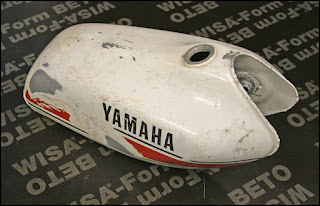 |
| Aluminum Yamaha MX fuel tank. |
Once I got it I noticed that the rear mounting bracket of the tank was broken. I removed the remains of it with an angle grinder and a sander. I cleaned the area below the old bracket with a sandblaster and a piece of sand paper.
I made a small bracket out of 3 mm aluminum sheet and bend it to a shape of a trapezoid. I finished it by filing a stadium shaped hole to bottom of it. Since I wasn't able to weld aluminum I visited Mikko from Speedhouse and he welded the bracket for me for a small reward. Mikko builds and maintains motorcycles for a living. You can find few pictures of the bikes he has build from his website: http://www.speedhouse.fi/albumi/pyoria/.
Tank didn't came with any locating dampers so I had to order a pair of them (3TB-24181-00) from one of my local Yamaha parts dealer. Once I had them it was easy to design a front mounting bracket for the tank.
 |
| Tank had a broken rear mounting bracket. |
 |
| New one is made out of 3 mm aluminum sheet. |
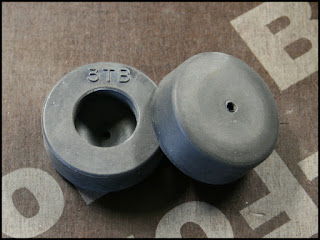 |
| Pair of locating dampers (3TB-24181-00). |
 |
| Underside of the tank. |
I started making the front mounting bracket by bending a suitable rounded shape out of approximately 80 mm wide steel sheet. I used 2 mm thick mild steel for two reasons. First one being formability and second structural strength. I made small bevels to both sides of the top plane of the bracket. That made sliding the tank to its place easier. I tack welded two thin pieces of sheet metal inside the bracket to keep the tank from moving sideways. Once that was done I tacked it to the top tube of the frame.
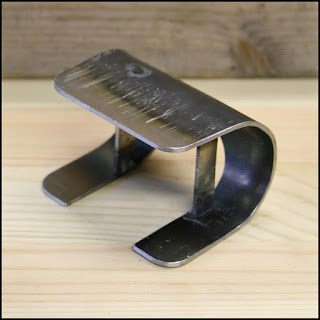 |
| Finished front mounting bracket. |
 |
| Side view. |
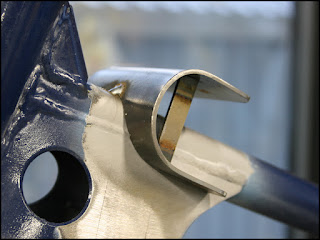 |
| Bracket tacked to the top tube of the frame. Seems like I forget to remove mill cinder before welding. |
Rear mounting bracket of the fuel tank needed a counter part, which I cut out of flat bar. I drilled a hole to the center of it and tacked a hexagon weld nut to the bottom of it. Once I figured the right angle for the tank I tacked the piece to the frame. I didn't want to weld either of the brackets definitively. If there's going to appear any fitment issues in the future, for example with triple clamps, it's easier to move their position.
 |
| Counter part for the rear mounting bracket. |
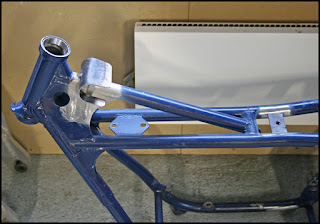 |
| Both brackets tacked in place. |
 |
| Test fit. |
Next time I'm going to start fitting the aluminum RM/PE 250 swingarm, which you can see in the background. Stay tuned for that next week!
Tunnisteet:
1973,
250,
aluminum fuel tank,
GT,
GT250,
GT250K,
project,
Suzuki,
vintage MX,
VMX,
Yamaha MX
Saturday 15 October 2016
'73 Suzuki GT250 - Part 2 - Mount for '87-90 Honda CR250 rear fender
Some of you might caught your eye to the small piece of flat bar welded to the rear part of this bike's frame. I made that bar to work as a support bracket for the rear fender I bought. For a while a had search for a proper rear fender. I started by going trough a catalog of Ufo Plast plastics. Rear fender for '87-90 Honda CR 125/250 (UFO-HO02601061) caught my eye and seemed like an easy fit since it required two pieces. I contacted few persons who were selling subframes for '87 Honda CR 250 on eBay and asked some key measurements. Luckily dimensions matched and I ended up ordering one from my local motorcycle parts store.
 |
| '87-90 Honda CR 125/250 rear fender made by Ufo Plast (UFO-HO02601061) |
Once it arrived I started making a support bracket for it. I made a simple template out of wood and bent a short piece of flat bar against it. I chose to use flat bar since it is pretty easy to bend just by hand. Even with mild steel there's always a little bit of spring back so you have compensate it by overbending. Once I had a rough shape I cut it to right angle with an angle grinder and welded it to the frame.
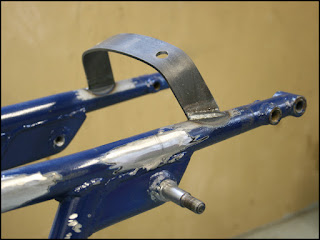 |
| Piece of flat bar bent to shape and welded to the frame. |
 |
| From a different angle. |
Last thing to do was to drill holes for fasteners and tack a pair of hexagon weld nuts on the bottom of the bracket. I chose to use M8 sized ones since I had them in stock. I still need to drill holes to both sides of the rear fender, but I will do that later.
 |
| Pair of M8 sized hexagon weld nuts. |
 |
| Tightened in place with hex screws and ready for welding. |
 |
| Underside view. |
 |
| Hexagon weld nut tack welded. |
 |
| Top view of finished rear fender mount. |
 |
| Rear fender on. |
 |
| Underside view. |
 |
| From another angle. |
Tunnisteet:
1973,
250,
73,
87-90,
CR,
GT,
GT250,
GT250K,
Honda,
project,
rear fender,
Suzuki,
UFO-HO02601061,
vintage MX,
VMX
Saturday 8 October 2016
'73 Suzuki GT250 - Part 1 - Something different
I have always liked the look of vintage motocross bikes and been wanting to own one. Especially ones with twinshocks have always appealed to me.
The idea of building one out of a GT 250 might sound crazy and have little sense but sometimes you're just forced to use what you got. I've owned this bike for a while now. I've also slowly been collecting parts for it. First idea was to build a vintage motocross bike styled supermoto out of it, which would have been great for street use, but I ended up scrapping that idea because it would have been a bit too expensive. So instead I decided to go with vintage MX style look.
I will try to build this bike with a smaller budget. I will mainly use second hand parts for it in exception of parts which will wear I will replace. Front forks and engine will remain stock but I will build a custom exhaust for it. Swingarm is from '79 Suzuki RM250 and tank from Yamaha MX 400 (if I'm correct). Front wheel will naturally be 1.60-21" and rear wheel 1.85-18". Front hub will stay stock and rear hub is coming from '79 RM125. I will get new laces made for them. Custom parts like seat, inner rear fender and airbox I will need to fabricate myself.
I will finish this post with a video of Iain Clark's '74 Maico 400 made by Chris Montignani, which has inspired me a lot regarding this project. There are a lot videos of cool vintage MX bikes on Chris' channel so go and check them out also.
 |
| '73 GT250 frame and pile of vintage MX parts. |
 |
| Stripped and cleaned frame. |
I will finish this post with a video of Iain Clark's '74 Maico 400 made by Chris Montignani, which has inspired me a lot regarding this project. There are a lot videos of cool vintage MX bikes on Chris' channel so go and check them out also.
Tuesday 4 October 2016
Yamaha RD 350 F2 '88 - Part 7 - Front fork maintenance
One of my RD's front fork seals was leaking oil through. To fix it I went and ordered a new seal kit from eBay made by Tourmax (FSD-002), which included both front fork seals and dust covers. I also replaced two metal slides (51L-23125-00 and 10V-23135-00) on both shocks, which help keep air inside the shock. I used same fork oil, Valvoline 10, as I used with my T250J front fork. While I had triple trees off the bike I went and greased both upper and lower steering ball bearings with a multipurpose grease.
 |
| Front fork seals and dust covers made by Tourmax. |
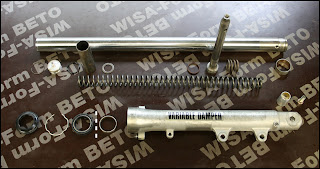 |
| Right front shock disassembled. Note that there is one piece missing from this picture. Right where the dotted line is supposed to be an O-ring (10V-23147-00), but which is actually a washer. |
 |
| New fork seals and dust covers in place. |
Tunnisteet:
2UA,
350,
dust cover,
dust seal,
F2,
front fork,
FSD-002,
maintenance,
oil seal,
project,
RD,
RD350,
RD350LC,
Tourmax,
Yamaha,
YPVS
Subscribe to:
Posts (Atom)









